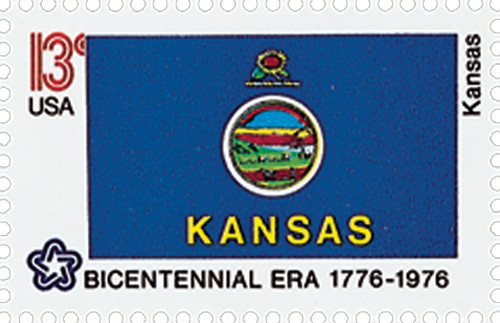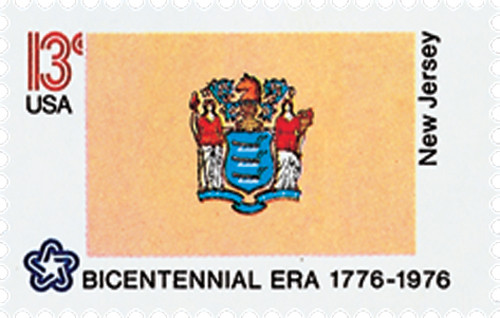
# 1666 - 1976 13c State Flags: Kansas
U.S. 1666
1976 Kansas
State Flags
American Bicentennial Series
• First time a sheet 50 had all different stamp designs
• Part of the American Bicentennial Series
Stamp Category: Commemorative
Series: American Bicentennial Series
Value: 13¢ First-class postage rate
First Day of Issue: February 23, 1976
First Day City(s): Washington, DC
Quantity Issued: 8,720,100 (panes of 50)
Printed by: Bureau of Engraving and Printing
Printing Method: Photogravure
Format: Sheet of 50
Perforations: 11
Why the stamp was issued:
The United States Postal Service celebrated the American Bicentennial with a full pane of the Union’s fifty state flags.
About the stamp design:
The State Flag of Kansas was designed in 1925 and officially adopted in 1927. It was flown for the first time over Fort Riley by Governor Ben Paulin for the troops stationed there, as well as for the National Guard. At the center of the flag is the Great Seal of the State of Kansas, which pictures a landscape before the rising sun, a river and steamboat (signifying commerce), a cabin with a man plowing a field (representing agriculture), and a wagon train heading west (depicting American expansion). Also pictured is a group of Indians hunting buffalo. The cluster of 34 stars symbolizes Kansas’ role as the 34th state of the American Union.
About the printing process:
Printed by the Bureau of Engraving and Printing on their seven-color Andreotti gravure press (601) which was their work horse for multicolored stamps.
About the American Bicentennial Series:
In the 1970s, America celebrated its 200th anniversary with hundreds of national events commemorating the heroes and historic events that led to our nation’s independence from Great Britain. The U.S. Postal Service issued 113 commemorative stamps over a six-year period in honor of the U.S. bicentennial, beginning with the American Revolution Bicentennial Commission Emblem stamp (U.S. #1432). As a group, the Bicentennial Series chronicles one of our nation’s most important chapters, and remembers the events and patriots who made the U.S. a world model for liberty.
Several of the stamps honored colonial life – craftsmen and communication. Other stamps honored important battles including Lexington and Concord, Bunker Hill, and Saratoga. Significant events such as the Boston Tea Party, the meeting of the First Continental Congress, and the Declaration of Independence were featured as well. The stamps also honored many significant people such as George Washington, Sybil Ludington, Salem Poor, and the Marquis de Lafayette.
Many of the stamps feature classic artwork. For instance, the set of four souvenir sheets picture important events recreated by noted artists such as John Trumbull. The Bicentennial Series also includes an important US postal first – the first 50-stamp se-tenant – featuring all 50 state flags. The format proved to be popular with collectors, and has been repeated many times since.
The American Bicentennial Series is packed with important US history – it tells the story of our nation’s fight for independence through stamps.
History the stamp represents:
On January 29, 1861, Kansas was admitted to the Union as America was on the brink of Civil War.
Four main tribes lived in eastern Kansas before white settlers arrived – the Kansa, Osage, Pawnee, and Wichita. After acquiring horses by the late 1700s, the Arapaho, Cheyenne, Comanche, Kiowa, and other tribes moved into the central plains to hunt buffalo.
Spanish explorer Francisco Vásquez de Coronado led the first whites into the area in 1541. Coronado’s expedition was looking for a land called Quivira, where an Indian guide told him he would find gold. No gold was found, and the Spanish left without creating a settlement. By the early 1600s, France had claimed much of North America, including Kansas. During the early 1700s, French fur trappers began to settle in what is now the northeastern corner of Kansas.
In 1803, France sold the vast Louisiana Territory to the United States, including most of Kansas. Many Indians from the East were resettled in Kansas for a time. But soon, whites began to settle the area. Some came as missionaries to the Indians and others decided to stay while traveling the Santa Fe Trail. In 1827, Colonel Henry Leavenworth opened the first U.S. outpost, Fort Leavenworth. By 1850, there was substantial pressure to open Kansas for white settlement. The Federal Government negotiated with Indians and reclaimed most of the land. In 1854, Kansas was declared open for settlement. The Indians were sent to reservations in Oklahoma – but some decided to fight. However, none of these groups were successful for long.
During the 1850s, Kansas became the center of the America’s fight over slavery, an issue which had divided the nation.
Kansas became a U.S. territory on May 30, 1854. Soon, settlers from the North and South were pouring into Kansas. Groups looking to influence the decision over slavery aided these people in an attempt to gain a majority. Proslavery candidates did well in the election. The fighting became so intense that newspapers began to call the territory “Bleeding Kansas.” Finally, politicians opposed to slavery were able to gain control of the legislature.
Kansas achieved statehood on January 29, 1861. At that time, several Southern states had already seceded from the Union. Within a few weeks, the Civil War erupted. Kansas was soon hit with a new wave of violence. Confederate raiders under William C. Quantrill burned most of the town of Lawrence, Kansas, and killed about 150 people. During the war, Kansas sent more men to the Union Army in proportion to its total population than any other state.
U.S. 1666
1976 Kansas
State Flags
American Bicentennial Series
• First time a sheet 50 had all different stamp designs
• Part of the American Bicentennial Series
Stamp Category: Commemorative
Series: American Bicentennial Series
Value: 13¢ First-class postage rate
First Day of Issue: February 23, 1976
First Day City(s): Washington, DC
Quantity Issued: 8,720,100 (panes of 50)
Printed by: Bureau of Engraving and Printing
Printing Method: Photogravure
Format: Sheet of 50
Perforations: 11
Why the stamp was issued:
The United States Postal Service celebrated the American Bicentennial with a full pane of the Union’s fifty state flags.
About the stamp design:
The State Flag of Kansas was designed in 1925 and officially adopted in 1927. It was flown for the first time over Fort Riley by Governor Ben Paulin for the troops stationed there, as well as for the National Guard. At the center of the flag is the Great Seal of the State of Kansas, which pictures a landscape before the rising sun, a river and steamboat (signifying commerce), a cabin with a man plowing a field (representing agriculture), and a wagon train heading west (depicting American expansion). Also pictured is a group of Indians hunting buffalo. The cluster of 34 stars symbolizes Kansas’ role as the 34th state of the American Union.
About the printing process:
Printed by the Bureau of Engraving and Printing on their seven-color Andreotti gravure press (601) which was their work horse for multicolored stamps.
About the American Bicentennial Series:
In the 1970s, America celebrated its 200th anniversary with hundreds of national events commemorating the heroes and historic events that led to our nation’s independence from Great Britain. The U.S. Postal Service issued 113 commemorative stamps over a six-year period in honor of the U.S. bicentennial, beginning with the American Revolution Bicentennial Commission Emblem stamp (U.S. #1432). As a group, the Bicentennial Series chronicles one of our nation’s most important chapters, and remembers the events and patriots who made the U.S. a world model for liberty.
Several of the stamps honored colonial life – craftsmen and communication. Other stamps honored important battles including Lexington and Concord, Bunker Hill, and Saratoga. Significant events such as the Boston Tea Party, the meeting of the First Continental Congress, and the Declaration of Independence were featured as well. The stamps also honored many significant people such as George Washington, Sybil Ludington, Salem Poor, and the Marquis de Lafayette.
Many of the stamps feature classic artwork. For instance, the set of four souvenir sheets picture important events recreated by noted artists such as John Trumbull. The Bicentennial Series also includes an important US postal first – the first 50-stamp se-tenant – featuring all 50 state flags. The format proved to be popular with collectors, and has been repeated many times since.
The American Bicentennial Series is packed with important US history – it tells the story of our nation’s fight for independence through stamps.
History the stamp represents:
On January 29, 1861, Kansas was admitted to the Union as America was on the brink of Civil War.
Four main tribes lived in eastern Kansas before white settlers arrived – the Kansa, Osage, Pawnee, and Wichita. After acquiring horses by the late 1700s, the Arapaho, Cheyenne, Comanche, Kiowa, and other tribes moved into the central plains to hunt buffalo.
Spanish explorer Francisco Vásquez de Coronado led the first whites into the area in 1541. Coronado’s expedition was looking for a land called Quivira, where an Indian guide told him he would find gold. No gold was found, and the Spanish left without creating a settlement. By the early 1600s, France had claimed much of North America, including Kansas. During the early 1700s, French fur trappers began to settle in what is now the northeastern corner of Kansas.
In 1803, France sold the vast Louisiana Territory to the United States, including most of Kansas. Many Indians from the East were resettled in Kansas for a time. But soon, whites began to settle the area. Some came as missionaries to the Indians and others decided to stay while traveling the Santa Fe Trail. In 1827, Colonel Henry Leavenworth opened the first U.S. outpost, Fort Leavenworth. By 1850, there was substantial pressure to open Kansas for white settlement. The Federal Government negotiated with Indians and reclaimed most of the land. In 1854, Kansas was declared open for settlement. The Indians were sent to reservations in Oklahoma – but some decided to fight. However, none of these groups were successful for long.
During the 1850s, Kansas became the center of the America’s fight over slavery, an issue which had divided the nation.
Kansas became a U.S. territory on May 30, 1854. Soon, settlers from the North and South were pouring into Kansas. Groups looking to influence the decision over slavery aided these people in an attempt to gain a majority. Proslavery candidates did well in the election. The fighting became so intense that newspapers began to call the territory “Bleeding Kansas.” Finally, politicians opposed to slavery were able to gain control of the legislature.
Kansas achieved statehood on January 29, 1861. At that time, several Southern states had already seceded from the Union. Within a few weeks, the Civil War erupted. Kansas was soon hit with a new wave of violence. Confederate raiders under William C. Quantrill burned most of the town of Lawrence, Kansas, and killed about 150 people. During the war, Kansas sent more men to the Union Army in proportion to its total population than any other state.


















